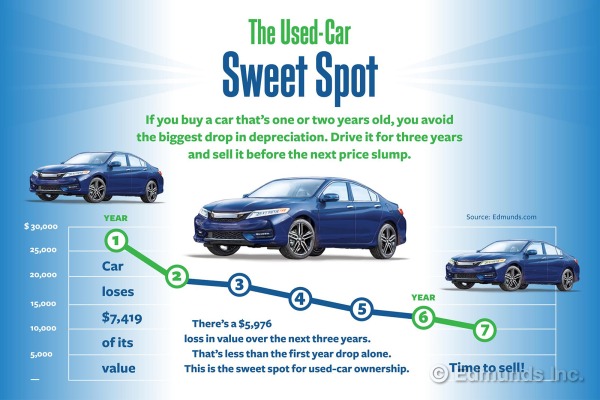
Everyone knows that cars lose a lot of their value as soon as they are driven off the lot. But few people realize that this presents a cost-saving opportunity for the savvy shopper.
According to Edmunds data, the first year is the most devastating for most new cars. Take an average midsize sedan selling for $27,660 as an example. In the first year, the car loses $7,419 of its value. However — and this is where the secret comes in — the next year only sees a $1,114 drop in value. In fact, in years two, three and four, it only loses $5,976. That's right — in those three years put together, it loses less than in that first year.

What this means for the frugal shopper is that buying a car in its second year, and owning it for three years, saves a boatload of money. What's the downside? Well, you don't have that new-car smell. And even a year-old car will have some wear and tear from the previous owner. In many cases, the bumper-to-bumper warranty will still be in effect and the powertrain warranty will continue beyond that, eliminating the likelihood that you'll have major expenses. Depending on the make, the car may be out of the bumper-to-bumper warranty for the fourth year.
This scenario of buying a one- or two-year-old car is perfect for shopping the certified pre-owned car market (CPO). Most manufacturers' CPO programs provide excellent used cars and extend the factory warranty. You can buy the car at a deep discount from the new car price and save money on depreciation, and you don't have to pay extra for a warranty.
To see which cars qualify best for this low-depreciation loophole, look at Edmunds.com True Cost to Own (TCO®). Pick a car and look at the depreciation from year to year. Also, look at how the related expenses will change as the car ages. Note that maintenance jumps up in the fourth and fifth years. That's because a four-year-old car will be approaching the 60,000-mile mark when the maintenance schedule calls for an extensive service visit. Also, the car will probably need new tires and brakes. Still, year to year, depreciation is the biggest expense in car ownership.
What happens after the fifth year? While Edmunds doesn't record this data, longtime used car dealers will say the value "drops like a rock." This second steep depreciation happens at different times for different types of cars. Luxury cars, in particular, see a steep drop sooner. Pickup trucks hold their value longer.
To understand the reason behind the second drop, you have to look at where a car is in its fifth year. If the car has been driven for 12,000 miles each year, there are 60,000 miles on the odometer. At 60,000 miles, if the car has been babied, it still is comfortably below the 100,000-mile mark. However, there are some rather major service issues looming, such as the replacement of the timing belt (in some cars), another set of tires and the slow oxidation of the paint.
Why should you care about this? Well, here's the good news. If you buy a car that is one or two years old, and drive it for three years, it will only cost you about $7,000: That's $2,333 per year. In other words, if you duck the initial depreciation drop, you have about the cheapest car-buying experience available.
The used-car market goes up and down based on a variety of factors. If you find yourself in a buyer's market, drive a hard bargain for a good used car. Then you are even farther ahead of the game from the beginning. Baby the car and put it up for sale again in a several years. You may find that you've had the pleasure of driving a (nearly) new car for (almost) free.
Not all cars age at the same rate. And the condition of a used car is still the most important factor. But if you can forego the new-car smell and head for the used car lot, you can cut your automotive expenses.